Lights, Camera, Action:Re-enacting
One of the Most Important Battles in World History
THE LIVING HISTORY VOLUNTEERS
The modern day "volunteers" are also from all walks
of life, with as many different outfits as there are persons.
They appear a bit 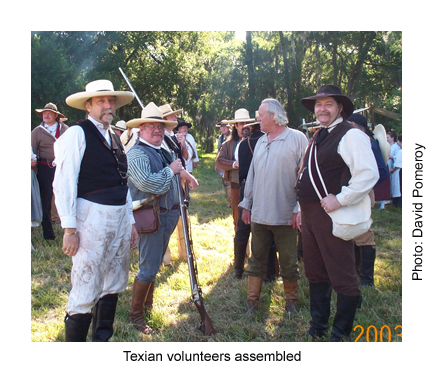 cleaner
than our ancestors-despite strong urging by their leaders, few
re-enactors agree to roll in the mud before they show up! However,
some do come with torn clothes, stains and unshaven faces. Volunteers
must be approved in advance in order to participate in the re-enactment.
No "walk-on" volunteers are accepted. Authenticity and
experience is a requirement. Safety is one of the highest priorities
and each volunteer is required to make safety meetings before
the event begins. The re-enactors chose which side they want to
fight on, but sometimes they are recruited for a specific camp
in order to balance the numbers. Over the years many volunteers
have fought on both sides. However, the final result is always
the same: The Texas Army wins!
cleaner
than our ancestors-despite strong urging by their leaders, few
re-enactors agree to roll in the mud before they show up! However,
some do come with torn clothes, stains and unshaven faces. Volunteers
must be approved in advance in order to participate in the re-enactment.
No "walk-on" volunteers are accepted. Authenticity and
experience is a requirement. Safety is one of the highest priorities
and each volunteer is required to make safety meetings before
the event begins. The re-enactors chose which side they want to
fight on, but sometimes they are recruited for a specific camp
in order to balance the numbers. Over the years many volunteers
have fought on both sides. However, the final result is always
the same: The Texas Army wins!

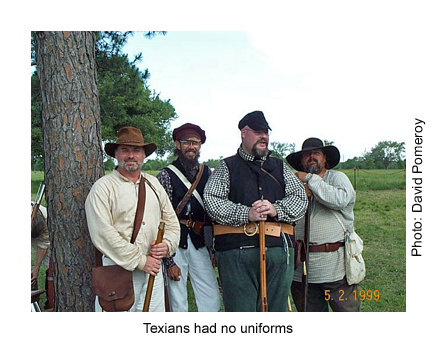
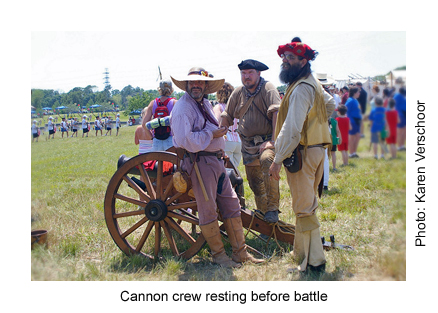
Each volunteer brings his or her own outfit which, with other
equipment and gear, can be worth upwards to a thousand dollars.
Many travel from New Mexico, Louisiana and far-off parts of Texas
to participate. Like the variety of volunteers in 1836, the re-enactors
are doctors, lawyers, welders, carpenters, small business owners,
teachers, housewives, secretaries, managers and retired persons.
Despite their background difference, each has three objectives
in mind: first, know their history; second, share that history
with the public; and third, have fun. Early Texas volunteer Noah
Smithwick summed up the attitudes of the 1836 volunteers: "The
citizens had taken up arms in self-defense; another class had
come through sympathy with their struggling countrymen; others,
still, for love of adventure..."
In the Texian Army Camp spectators visit with the soldiers
and inquire about their clothing, weapons and reasons for fighting
for Texas. Gunsmithing, black powder cartridge making, blacksmithing,
musket ball molding, leatherwork and whittling are demonstrated.
Young spectators are pressed into service as a militia where they
are trained in the manual of arms and marching. Some are even
selected to man the famous Twin Sister's cannon. Periodically
the re-enactors are mustered and fire salutes, either with black-powder
muskets, pistols or cannon. This is always a delight for the spectators.
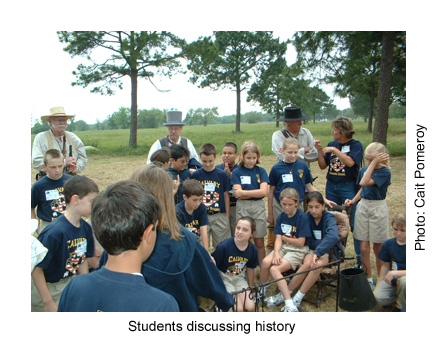
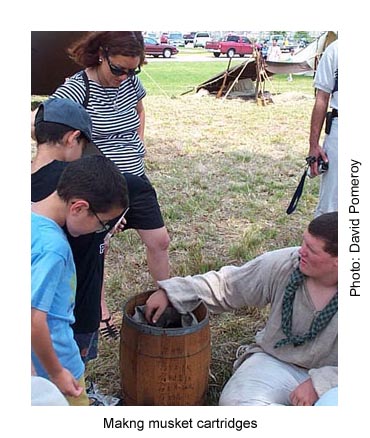
Across the battlefield is the Mexican Army Camp. This
camp has a more traditional military look, with its neat row of
white canvas tents and uniformed soldiers drilling. Young spectators
are also drafted into the Mexican Army but must learn their orders
in Spanish. General Santa Anna traveled with a red and white marquee
tent, fully furnished with silver and china. Visitors are encouraged
to look inside. 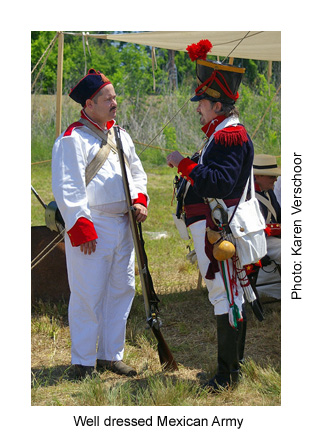 Flying
outside his tent are several of the Mexican flags replicating
those at the original battle. If you are lucky, a surgeon will
be on duty and will demonstrate the tools and medicines of the
day.
Flying
outside his tent are several of the Mexican flags replicating
those at the original battle. If you are lucky, a surgeon will
be on duty and will demonstrate the tools and medicines of the
day. 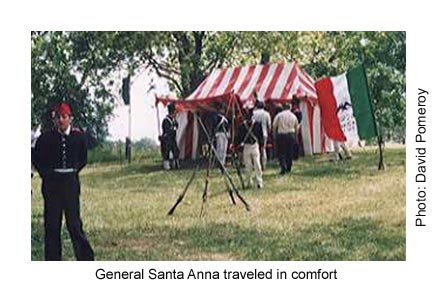 Normally
his presentation is interrupted by groans and yells of pretend
pain at the primitive implements used in 1836. Nearby the wives,
girlfriends, family, and other camp followers are cooking and
mending clothes. The public is encouraged to sit and visit for
a while.
Normally
his presentation is interrupted by groans and yells of pretend
pain at the primitive implements used in 1836. Nearby the wives,
girlfriends, family, and other camp followers are cooking and
mending clothes. The public is encouraged to sit and visit for
a while.
PAGE 4 CALL
TO ARMS
05.07.2013
 cleaner
than our ancestors-despite strong urging by their leaders, few
re-enactors agree to roll in the mud before they show up! However,
some do come with torn clothes, stains and unshaven faces. Volunteers
must be approved in advance in order to participate in the re-enactment.
No "walk-on" volunteers are accepted. Authenticity and
experience is a requirement. Safety is one of the highest priorities
and each volunteer is required to make safety meetings before
the event begins. The re-enactors chose which side they want to
fight on, but sometimes they are recruited for a specific camp
in order to balance the numbers. Over the years many volunteers
have fought on both sides. However, the final result is always
the same: The Texas Army wins!
cleaner
than our ancestors-despite strong urging by their leaders, few
re-enactors agree to roll in the mud before they show up! However,
some do come with torn clothes, stains and unshaven faces. Volunteers
must be approved in advance in order to participate in the re-enactment.
No "walk-on" volunteers are accepted. Authenticity and
experience is a requirement. Safety is one of the highest priorities
and each volunteer is required to make safety meetings before
the event begins. The re-enactors chose which side they want to
fight on, but sometimes they are recruited for a specific camp
in order to balance the numbers. Over the years many volunteers
have fought on both sides. However, the final result is always
the same: The Texas Army wins!




 Flying
outside his tent are several of the Mexican flags replicating
those at the original battle. If you are lucky, a surgeon will
be on duty and will demonstrate the tools and medicines of the
day.
Flying
outside his tent are several of the Mexican flags replicating
those at the original battle. If you are lucky, a surgeon will
be on duty and will demonstrate the tools and medicines of the
day.  Normally
his presentation is interrupted by groans and yells of pretend
pain at the primitive implements used in 1836. Nearby the wives,
girlfriends, family, and other camp followers are cooking and
mending clothes. The public is encouraged to sit and visit for
a while.
Normally
his presentation is interrupted by groans and yells of pretend
pain at the primitive implements used in 1836. Nearby the wives,
girlfriends, family, and other camp followers are cooking and
mending clothes. The public is encouraged to sit and visit for
a while.